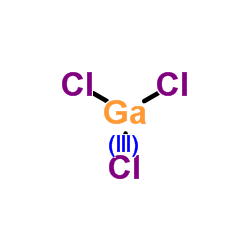Gallium trichloride

Gallium trichloride structure
|
Common Name | Gallium trichloride | ||
|---|---|---|---|---|
| CAS Number | 13450-90-3 | Molecular Weight | 176.082 | |
| Density | 2.47 | Boiling Point | 201.03ºC | |
| Molecular Formula | Cl3Ga | Melting Point | 77.9ºC | |
| MSDS | Chinese USA | Flash Point | -26 °F | |
| Symbol |





GHS02, GHS05, GHS07, GHS08, GHS09 |
Signal Word | Danger | |
|
Cleavable Molecular Beacon for Hg(2+) Detection Based on Phosphorothioate RNA Modifications.
Anal. Chem. 87 , 6890-5, (2015) Mercury is a highly toxic heavy metal, and detection of Hg(2+) by biosensors has attracted extensive research interest in the past decade. In particular, a number of DNA-based sensing strategies have been developed. Well-known examples include thymine-Hg(2+) ... |
|
|
Isolation and structure determination of new siderophore albachelin from Amycolatopsis alba.
Biometals 28(2) , 381-9, (2015) A new siderophore named albachelin was isolated from iron deficient culture of Amycolatopsis alba. The planar structure of albachelin was elucidated by the combination of ESI-MS/MS experiment and NMR spectroscopic analyses of the gallium (III) complex. The st... |
|
|
Cyclopropylmethylation of benzylic and allylic chlorides with cyclopropylmethylstannane catalyzed by gallium or indium halide.
Org. Lett. 12(7) , 1520-3, (2010) Benzylic and allylic chlorides easily coupled with cyclopropylmethylstannane in the presence of GaCl(3) or InBr(3) catalyst, in which an intermediate of an active butenylgallium or -indium species was confirmed by NMR spectroscopy and X-ray analysis. An ionic... |
|
|
Highly luminescent InP/GaP/ZnS QDs emitting in the entire color range via a heating up process.
Sci. Rep. 6 , 30094, (2016) InP-based quantum dots (QDs) have attracted much attention for use in optical applications, and several types of QDs such as InP/ZnS, InP/ZnSeS, and InP/GaP/ZnS have been developed. However, early synthetic methods that involved rapid injection at high temper... |
|
|
Ventilation distribution studies comparing Technegas and "Gallgas" using 68GaCl3 as the label.
J. Nucl. Med. 52(2) , 206-9, (2011) Ventilation distribution can be assessed by SPECT with Technegas. This study was undertaken in piglets with different degrees of ventilation inhomogeneity to compare PET using (68)Ga-labeled pseudogas or "Gallgas" with Technegas.Twelve piglets were studied in... |
|
|
68Ga-labeling and in vivo evaluation of a uPAR binding DOTA- and NODAGA-conjugated peptide for PET imaging of invasive cancers.
Nucl. Med. Biol. 39(4) , 560-9, (2012) The urokinase-type plasminogen activator receptor (uPAR) is a well-established biomarker for tumor aggressiveness and metastatic potential. DOTA-AE105 and DOTA-AE105-NH(2) labeled with (64)Cu have previously been demonstrated to be able to noninvasively monit... |
|
|
Potential use of 68Ga-apo-transferrin as a PET imaging agent for detecting Staphylococcus aureus infection.
Nucl. Med. Biol. 38(3) , 393-8, (2011) (67)Ga citrate has been extensively used to detect infection and inflammation since 1971. However, its clinical utility is compromised due to several limitations. The present project explored whether (68)Ga-apo-transferrin ((68)Ga-TF), when prepared in vitro,... |
|
|
Semiquantitative 67Ga scintigraphy as an indicator of response to and prognosis after corticosteroid treatment in idiopathic interstitial pneumonia.
J. Nucl. Med. 46(9) , 1421-6, (2005) The prognosis in some forms of idiopathic interstitial pneumonia (IIP), especially idiopathic pulmonary fibrosis (IPF) and fibrotic nonspecific interstitial pneumonia (NSIP), is still poor. A minority of patients will respond to immunosuppressive treatment. I... |
|
|
[Cytocompatibility of dental alloys containing palladium].
Rev. Stomatol. Chir. Maxillofac. 98 Suppl 1 , 66-8, (1997) The cytoxicity and the 50% lethal concentration (LC50) has been assessed in vitro by the colony forming method in extracts of 5 precious or semiprecious alloys and of oxides and chlorides of the metal contained in these alloys: Pd, Ag, Cu, Zn, Sn, In and Ga. ... |
|
|
Synthesis and evaluation of diastereoisomers of 1,4,7-triazacyclononane-1,4,7-tris-(glutaric acid) (NOTGA) for multimeric radiopharmaceuticals of gallium.
Bioconjug. Chem. 23(11) , 2229-38, (2012) In the conventional synthesis of 1,4,7-tris-(glutaric acid)-1,4,7-triazacyclononane (NOTGA), four isomeric species are usually generated by the alkylation of 1,4,7-triazacyclononane with α-bromoglutaric acid diester. To estimate their biological efficacies as... |